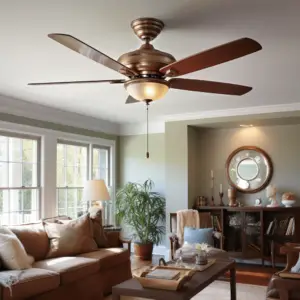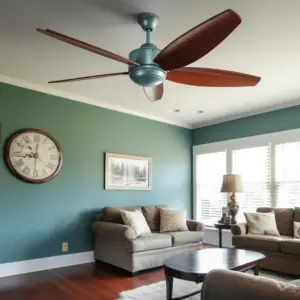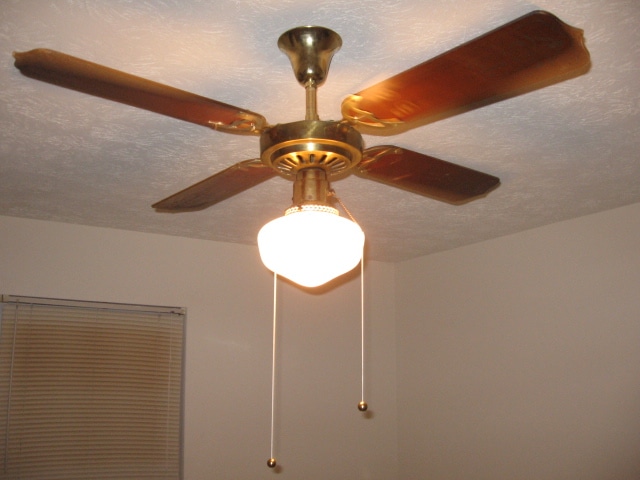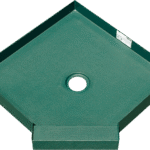Ceiling Fan Issues fans are a great way to keep cool during the summer. They also come in handy during winter months to keep your room warm, making them an excellent addition to your home year-round. However, they do have their problems.
One of the most common problems with ceiling fans is that sometimes they tend to stop blowing air. And as you probably already know, a faulty ceiling fan can be annoying, not to mention the fact that it can be a safety hazard.
While this can be caused by various reasons, including that the blades are dirty or there is something blocking the blades from spinning freely, this article seeks to explain the major causes of a problematic ceiling fan and how to resolve the issue.
So if you are dealing with a broken ceiling fan and don’t know how to fix it, this article will show you how.
Table of Contents
Ceiling Fan Not Blowing Air: What Could be the problem?

Technically speaking, ceiling fans are used to circulate air around a room. Therefore, when the blades of the fan stop spinning, it means that the power has been cut off.
If your ceiling is not blowing air, check whether the power is on, whether the switch is set on and whether or not the blades are loose or damaged.
There are many reasons why a ceiling fan might stop spinning. The most common one is that there is a power interruption or the power switch has been turned off. It could also be due to a mechanical failure in the motor or other components of the fan, such as its capacitor or rotor armature.
It could also be that the blades are dirty or there is something blocking the blades from spinning freely. In case the blades are dirty or dusty, you will need to get them cleaned.
Use a dry cloth or vacuum cleaner and if that doesn’t work, you might have to replace the blade assembly or sometimes the motor on the ceiling fan. Nonetheless, here’s a breakdown of the same:
Incorrect Fan Blade Rotation
The direction the fan spins directly determines whether or not you feel the air. If the fan blades are rotating in the wrong direction they will not provide adequate cooling to your room. As opposed to popular misconception, you won’t feel the airflow too much if the fan is set to clockwise rotation
When a fan rotates to the left (clockwise), it pulls air upward, sending the air throughout the room and down the walls.
On the other hand, a fan moving counterclockwise will push the air downward. You will feel the air directly under the fan, but not really when you stand to its side. Nearly all ceiling fans have a switch that allows you to adjust the direction.
How to Fix
Adjusting or resetting your fan’s direction is quite simple. Simply turn off the fan to stop it from rotating. It’s a terrible idea to try any fixation while the fan is still moving.
Then locate the switch near the motor’s base, usually above the fan blades. Flip the switch to the other direction, making sure it is locked so it doesn’t swing back to the clockwise setting. Your fan should rotate counterclockwise, pushing the air down onto the flow below it.
It turns out that all you have to do is turn on the fan to watch it flow in the right appropriate direction. So just check whether your fan has been switched, or has been adjusted before the manufacturer shipped it.
Wrong Ceiling Fan Size
If your fan is too small, you won’t feel the air as expected. There are many ways a fan can be unsuitable for a room, including failing to cover given square footage.
Small fan blades also don’t provide enough air. Likewise, small fan motors don’t offer enough power for heavy blades or high speeds. That means you will be stuck with a sluggish, slow fan that can’t catch up and make a noticeable difference.
How to Fix
Consider upgrading your ceiling’s fan blades to increase the fan’s effectiveness. A short-bladed fan will not be of much help for a large room. Instead, get fan blades between 48 and 60 inches. Bigger blades blow more air, meaning, you can gauge the right size based on the room’s square footage.
Fortunately, most ceiling fans can accommodate new bigger blades without you having to replace the base or motor. Simply unscrew every blade from the fan’s arm and slide in the new blades. That said, avoid going for too heavy blades as they can pull the motor down.
Tilted Motor Base

Constant wear and tear can tilt the base of the motor. If the ceiling fan wobbles or looks somewhat different than it used to, then it means the base has tilted. A tilted base basically puts more weight on one side than the other, causing a sluggish rotation.
How to Fix
To fix this, simply tighten the screws mounting the base to the ceiling. Then secure all the blade screws to their respective arms to stop them from wobbling. Check whether the ceiling screws are tripped, which could cause a loose grip.
Then use drywall screws if the ceiling is made of chalky, old drywall. Remember to tighten any hanging chains, switches, and other parts that turn on the fan. If none of these work and the ceiling fan still hangs, you might have to climb into the attic and make sure it is well secured up there.
Fan Height Issues
The height of your ceiling fan can affect its performance. If the fan is too high, you won’t get enough airflow. These effects are associated with small blades and motors. In case you have high ceilings, you might have to hang the fan low enough to make an impact. Bigger blades can be particularly great for this issue.
How to Fix
If the fan is hanging on a pole or chain, you can simply adjust the height by removing some of the chains. Keep the adjustments within 1-2 inches, and then test the fan to see if further adjustments are necessary. Mounted fans that use a stationary base require to be replaced if the height cannot be altered. Luckily, most motor bases are short enough to keep the fan as high as possible.


